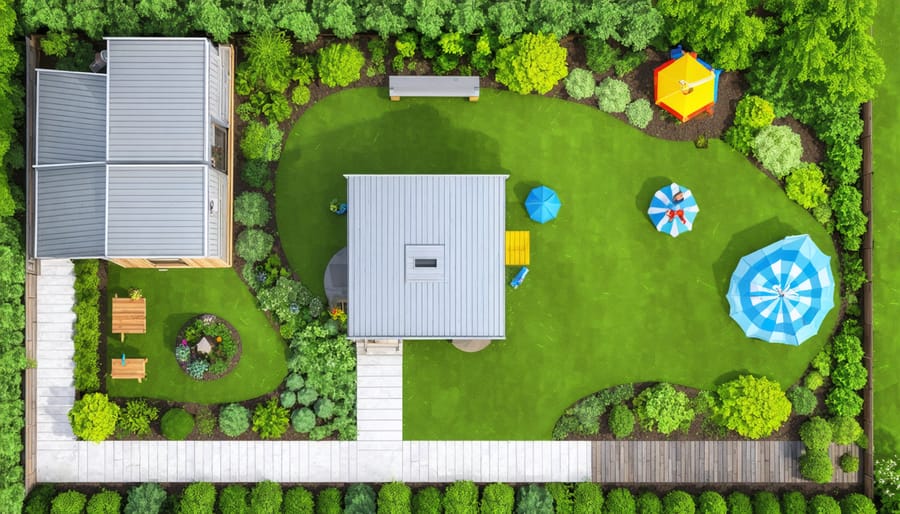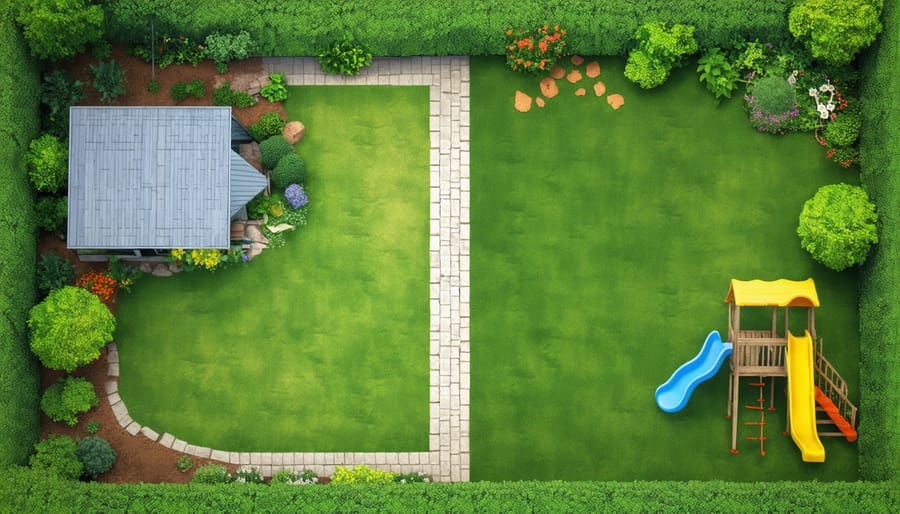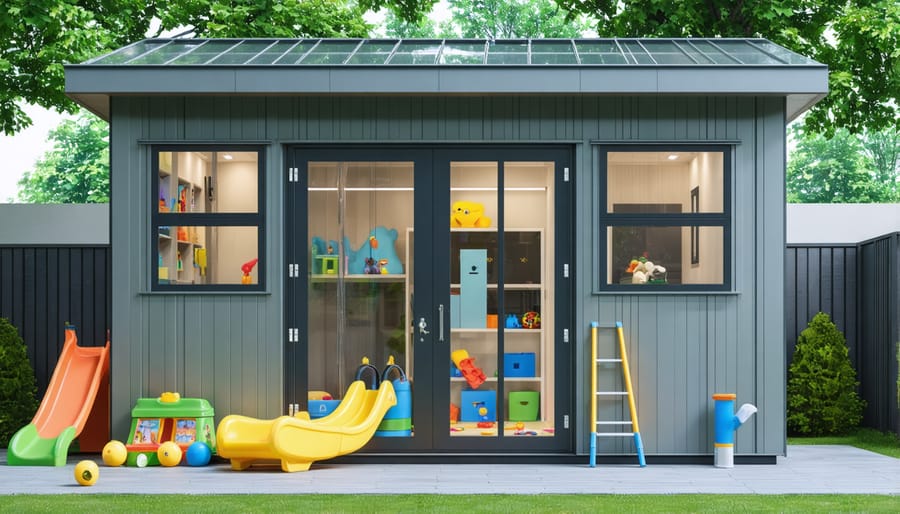Transform Your Backyard: Smart Shed Placement for the Perfect Play Area

Transform your backyard into a harmonious space where storage meets play by strategically positioning your shed. The right shed placement creates dedicated zones for both storage and recreation, maximizing your outdoor living area while ensuring children’s safety. Consider factors like sight lines from main living areas, natural walking paths, and existing landscape features when selecting the perfect spot. Whether you’re installing a compact garden shed or a larger storage building, thoughtful placement becomes the cornerstone of a well-designed yard that serves multiple purposes.
A properly positioned shed not only provides essential storage but can also act as a natural boundary for play areas, create micro-climates for gardens, and even serve as an architectural anchor for your outdoor space. By balancing practical considerations with creative design principles, your shed placement decision will enhance both the functionality and enjoyment of your backyard for years to come.
Creating Play-Friendly Zones With Smart Shed Positioning
Safe Distance Planning
When positioning your shed near play areas, safety should be your top priority. A good rule of thumb is to maintain at least 6-8 feet of clearance between your shed and any play equipment. This buffer zone ensures children have enough room to move freely and safely around both structures.
For swing sets, increase this distance to at least 10 feet from the shed, accounting for the swing’s full range of motion plus additional safety space. If your shed has windows, position them away from active play zones to prevent accidental breakage from flying balls or toys.
Consider creating designated pathways between play areas and the shed using materials like rubber mulch or stepping stones. This helps establish clear boundaries and reduces the risk of collision during excited play. Remember to keep shed doors facing away from play zones when possible, preventing unexpected door swings from interfering with children’s activities.
For properties with limited space, install protective barriers like decorative fencing or landscaping between the shed and play area. This creates both a visual and physical separation while maintaining your yard’s aesthetic appeal.

Visibility Considerations
When positioning your shed near a play area, strategic placement is crucial for maintaining clear sightlines to supervise children. Consider placing the shed where it won’t create blind spots or hidden corners that could obstruct your view of the play space. A well-planned layout might include installing shed windows on multiple sides, allowing you to keep an eye on activities while working inside.
Angle your shed so that its shorter side faces the play area, minimizing visual obstruction. If possible, position it against a fence or property line, leaving open sight lines across your yard. This arrangement creates a natural boundary while maximizing visibility. Consider creating a designated pathway between the shed and play area, ensuring safe access while maintaining clear views.
For enhanced supervision, keep vegetation around the shed well-trimmed and avoid placing tall plants or structures that could create hiding spots. If your yard has multiple levels, position the shed on the higher ground for better oversight of the play space below. Remember, good visibility not only improves safety but also helps create a more connected outdoor living space where children can play freely while remaining within sight.

Double-Duty Shed Solutions
Play Equipment Storage Integration
Transform your shed’s walls and spaces into an organized haven for play equipment with smart storage solutions. Install adjustable pegboard systems on interior walls to hang lighter items like jump ropes, badminton rackets, and pool toys. Use heavy-duty hooks and brackets to store bulkier equipment like bikes and scooters vertically, maximizing floor space.
Create designated zones within your shed by adding labeled bins and shelving units. Clear plastic containers work wonderfully for smaller items like chalk, bubbles, and sports balls, while mesh bags can hold beach toys and allow sand to fall through. Consider installing a fold-down table or workbench that doubles as a maintenance station for equipment repairs and a staging area for outdoor activities.
Make use of often-overlooked spaces by adding over-the-door organizers for smaller items and ceiling-mounted storage racks for seasonal equipment like sleds and pool floats. Install motion-sensor lights to help kids locate items easily and ensure safe access. Remember to position frequently used items at child-height while keeping heavier or more dangerous equipment stored up high and out of reach.
Multi-Purpose Design Ideas
Transform your shed’s exterior walls into dynamic activity zones that serve multiple purposes while maximizing your outdoor space. Consider installing a climbing wall on one side using weather-resistant climbing holds and safety padding below – it’s a fantastic way to create an enchanting play space that keeps kids active and entertained. Another wall can become an outdoor art station by mounting a large chalkboard or weatherproof easel, perfect for encouraging creativity while keeping art supplies organized inside the shed.
Turn the remaining sides into game areas by painting checker or tic-tac-toe boards directly onto the walls, or install a fold-down table for puzzles and board games. Consider adding removable targets for ball games or bean bag toss activities. These multi-purpose solutions not only maximize your shed’s utility but also create designated activity zones that help keep toys and games organized while providing endless entertainment options for the whole family.
Remember to use weather-resistant materials and maintain clear access to your shed’s entrance. Regular safety checks of all play elements will ensure long-lasting enjoyment of these creative additions.

Safety-First Placement Strategies
When placing a shed near play areas, safety should be your top priority. Start by ensuring you prepare your site properly with adequate clearance from play equipment and high-traffic zones. A good rule of thumb is to maintain at least 10 feet between your shed and any playground equipment, allowing children plenty of room to run and play safely.
Consider visibility when choosing your shed’s location. Position it where you can easily monitor children’s activities from inside your home. Avoid creating blind spots or hidden areas that could pose safety risks during playtime. Installing motion-sensor lighting around the shed can enhance visibility during early morning or evening hours.
The shed’s entrance should face away from play zones to prevent collision risks when doors are opened. If possible, create a designated pathway to the shed that doesn’t intersect with play areas. This separation helps prevent accidents when adults need to access storage while children are playing.
Install rounded corner guards on your shed’s exterior corners if they’re within reach of play areas. Consider adding rubber mulch or safety surfacing around the shed’s perimeter, especially if it’s near swing sets or climbing equipment. This extra cushioning can help prevent injuries from accidental bumps or falls.
Remember to secure all shed doors with child-resistant locks and keep potentially dangerous items stored high and out of reach. Regular maintenance checks ensure there are no protruding nails, loose boards, or other hazards that could harm children during play.
Choosing the perfect spot for your shed is more than just finding an empty corner in your yard – it’s about creating a harmonious balance between functionality and aesthetics. By considering factors like terrain, accessibility, and local regulations, you can ensure your shed serves its purpose while enhancing your property’s value. Remember to prioritize proper drainage, sunlight exposure, and distance from property lines when making your final decision.
Whether you’ve opted for a classic garden corner placement or a creative integration with your existing landscape, your shed can become a beautiful and practical addition to your outdoor space. Don’t forget to consider future needs when positioning your shed, as this will save you time and effort down the road.
Take the time to evaluate all the placement options we’ve discussed, and don’t hesitate to consult with local professionals if you need additional guidance. With careful planning and thoughtful consideration, your shed can become not just a storage solution, but a valuable asset that complements your home and lifestyle for years to come.

